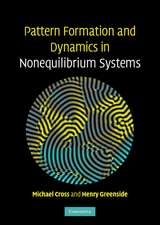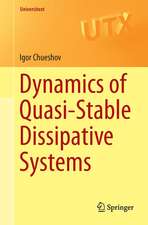Dynamics of Self-Organized and Self-Assembled Structures
Autor Rashmi C. Desai, Raymond Kapralen Limba Engleză Hardback – 25 mar 2009
Preț: 582.52 lei
Preț vechi: 654.52 lei
-11% Nou
Puncte Express: 874
Preț estimativ în valută:
111.48€ • 115.96$ • 92.03£
111.48€ • 115.96$ • 92.03£
Carte tipărită la comandă
Livrare economică 12-26 aprilie
Preluare comenzi: 021 569.72.76
Specificații
ISBN-13: 9780521883610
ISBN-10: 052188361X
Pagini: 342
Ilustrații: 60 b/w illus.
Dimensiuni: 179 x 254 x 20 mm
Greutate: 0.82 kg
Editura: Cambridge University Press
Colecția Cambridge University Press
Locul publicării:Cambridge, United Kingdom
ISBN-10: 052188361X
Pagini: 342
Ilustrații: 60 b/w illus.
Dimensiuni: 179 x 254 x 20 mm
Greutate: 0.82 kg
Editura: Cambridge University Press
Colecția Cambridge University Press
Locul publicării:Cambridge, United Kingdom
Cuprins
Preface; 1. Self-organized and self-assembled structures; 2. Order parameter, free energy and phase transitions; 3. Free energy functional; 4. Phase separation kinetics; 5. Langevin model for nonconserved order parameter systems; 6. Langevin model for conserved order parameter systems; 7. Interface dynamics at late times; 8. Domain growth and structure factor for model B; 9. Order parameter correlation function; 10. Vector order parameter and topological defects; 11. Liquid crystals; 12. Lifshitz-Slyozov-Wagner theory; 13. Systems with long-range repulsive interactions; 14. Kinetics of systems with competing interactions; 15. Competing interactions and defect dynamics; 16. Diffusively-rough interfaces; 17. Morphological instability in solid films; 18. Propagating chemical fronts; 19. Transverse front instabilities; 20. Cubic autocatalytic fronts; 21. Competing interactions and front repulsion; 22. Labyrinthine patterns in chemical systems; 23. Turing patterns; 24. Excitable media; 25. Oscillatory media and complex Ginzburg-Landau equation; 26. Spiral waves and defect turbulence; 27. Complex-oscillatory media; 28. Resonantly-forced oscillatory media; 29. Nonequilibrium patterns in laser-induced melting; 30. Reaction dynamics and phase segregation; 31. Active materials; References; Index.
Recenzii
'I recommend this book. It is a practical no-nonsense cookbook which should be on the bookshelves of graduate students in this area.' Martin Grant, Physics in Canada
'The authors made a significant effort to describe the main principles of pattern formatio in a transparent manner … The book is generously illustrated and has a useful index … a useful reference for graduate students and researchers in many fields including nonlinear dynamics, engineering, biophysics [and] statistical mechanics …' Zentralblatt MATH
'I enthusiastically recommend this book to graduate students and young researchers entering the exciting and truly interdisciplinary field of self-organization and self-assembly in complex systems. The book is very useful, provides an excellent source of reference material, and is clearly a valuable asset and excellent introduction not only for graduate students, but also for professors looking to build a course on pattern formation and self-assembly.' Igor Aranson, Argonne National Laboratory
'This book is a practical collection of topics in pattern formation, worked through step by step. Each topic is given a brief, even breezy discussion; the 31 chapters whip by five or ten pages each. Overall, I recommend this book. It is a practical, no-nonsense cookbook which should be on the bookshelves of graduate students in this area.' Martin Grant, McGill University
'While the book includes a broad range of topics it is easily readable even by non-specialists … I enthusiastically recommend this book to graduate students and young researchers … very useful … clearly a valuable asset …' Journal of Statistical Physics
'The text is very well written and grips the attention of the reader. It is pitched at a level that will be understandable to graduate students, and much of it will be accessible to final year undergraduates. There are numerous figures and illustrations to illuminate the text, an extensive list of references, and a good index. In my opinion, it is an excellent book that can be recommended warmly both to libraries and for personal purchase by physicists and nonlinear dynamicists, especially hose working or teaching in the area of self-organisation.' Contemporary Physics
'The authors made a significant effort to describe the main principles of pattern formatio in a transparent manner … The book is generously illustrated and has a useful index … a useful reference for graduate students and researchers in many fields including nonlinear dynamics, engineering, biophysics [and] statistical mechanics …' Zentralblatt MATH
'I enthusiastically recommend this book to graduate students and young researchers entering the exciting and truly interdisciplinary field of self-organization and self-assembly in complex systems. The book is very useful, provides an excellent source of reference material, and is clearly a valuable asset and excellent introduction not only for graduate students, but also for professors looking to build a course on pattern formation and self-assembly.' Igor Aranson, Argonne National Laboratory
'This book is a practical collection of topics in pattern formation, worked through step by step. Each topic is given a brief, even breezy discussion; the 31 chapters whip by five or ten pages each. Overall, I recommend this book. It is a practical, no-nonsense cookbook which should be on the bookshelves of graduate students in this area.' Martin Grant, McGill University
'While the book includes a broad range of topics it is easily readable even by non-specialists … I enthusiastically recommend this book to graduate students and young researchers … very useful … clearly a valuable asset …' Journal of Statistical Physics
'The text is very well written and grips the attention of the reader. It is pitched at a level that will be understandable to graduate students, and much of it will be accessible to final year undergraduates. There are numerous figures and illustrations to illuminate the text, an extensive list of references, and a good index. In my opinion, it is an excellent book that can be recommended warmly both to libraries and for personal purchase by physicists and nonlinear dynamicists, especially hose working or teaching in the area of self-organisation.' Contemporary Physics
Notă biografică
Descriere
Describes pattern formation processes and how they can be modeled for graduate-level courses.












